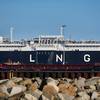The National Transportation Safety Board (NTSB) cited inappropriate navigational procedures and equipment as the result of the 2001 grounding of the New York Fast Ferry's small passenger vessel, the Finest. NTSB listed that the probable cause of the grounding that occurred outside the channel to the Shrewsbury River, Sandy Hook Bay, N.J. was the lack of readily visible fixed navigational aids, as well as the failure of New York Fast Ferry to require the use of installed navigation equipment and to set guidelines for operations in adverse environmental conditions.
On January 4, 2001, the Finest, with 258 passengers on board, was en route for the Sandy Hook Bay Marina in Highlands, N.J. after departing Manhattan. The master diverted the vessel to pass clear of an ice field that covered his normal route to the channel and made an approach with the channel buoys obscured by the ice. The master's turn into the channel entrance was based on his visual observations of the marina's lights. The vessel grounded about 300 yards east of the channel. No injuries or deaths resulted from the accident; however, one person on board had to be evacuated from the vessel by helicopter for medical treatment of an allergic reaction unrelated to the accident.
On the trip during which the vessel grounded, the master chose to deviate from his normal approach to avoid an ice field. Instead of a direct course from buoy 17 to the channel, the master headed the vessel in a southerly direction toward Atlantic Highland breakwater and made the approach to the Shrewsbury channel from the west. To enter the channel, the master had to make a 90-degree starboard turn without the use of the buoys as references, despite that he had sufficient electronic navigation equipment available to have executed the maneuver safely.
The Board found that the Finest's navigation and communications equipment included two VHF-FM marine band radios, two 3-cm radars, one automatic radar plotting aid equipped, one PinPoint electronic chart plotter, one GPS with a differential GPS, one autopilot, one digital gyro compass, and six portable FM business band radios. After the incident, the Board found that the master was asked, if faced with the same circumstances in the future, what could he have done differently to avoid grounding the vessel. The master recommended that the Coast Guard Break up the ice or have a range installed. He also recommended that the company have an alternate landing site. The master was also unaware of any alternatives to using the buoys when entering the marina. According to the Board there were a number of alternative methods of navigation that the master could have used to safely navigate the vessel into the marina. He could have set his radar's VRM to a range of .5 mile to serve as a danger marker. The master could have also determined the true course line of the channel and adjusted his EBL to display either the true or relative bearing from his easterly heading. At the point that the EBL was aligned into the marina, while the VRM became tangent with the land mass, the mate would know what the vessel was at the point where it was safe for it to head toward the marina. The master could also have used a prominent shoreline point to obtain a fix based on the range and bearing to that point. The Atlantic Highlands breakwater light would have provided a prominent mark for the master to fix the vessel's position. Another option that the master could have employed to determine the vessels' position was to use the PinPoint chart plotter with the appropriate GPS input. Had the master used radar and and bearing, or the GPS with the PinPoint chart plotter instead of inaccurate estimation he could have avoided human err and instead, established the vessel's position and navigate the vessel into the marina. The Safety Board concludes that the master could have successfully made the transit into the Shrewsbury River by using the navigational equipment that was available. The NTSB recommended to the Coast Guard to install beacons to augment or replace buoys at the entrance to the Shrewsbury River Channel. The Board recommended that New York Fast Ferry should establish and implement requirements where vessel masters and crewmembers with navigational responsibilities employ all installed vessel navigation equipment, in addition to establishing standards for navigation in poor environmental conditions.
Featured videos

Unlock Onboard Data Efficiencies

Tracking Foreign Vessels Working in the U.S. Jones Act Market

Inmarsat Enhances Service to Drive Digitalization
Subscribe for
Maritime Reporter E-News
Maritime Reporter E-News is the maritime industry's largest circulation and most authoritative ENews Service, delivered to your Email five times per week









